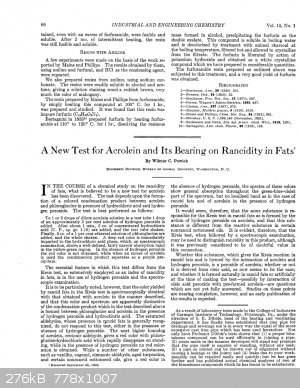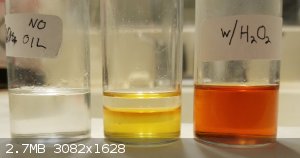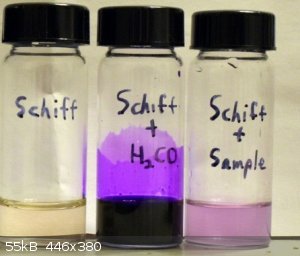sbreheny
Hazard to Others
  
Posts: 145
Registered: 30-1-2014
Member Is Offline
Mood: No Mood
|
|
Test for acrolein
Hi all,
I have a sample of liquid which I believe, based on smell, contains some acrolein (smells like burnt fat) but I'd like to confirm this. I believe that
the other main constituents of the liquid are water, mineral oil, partially-oxidized paraffin wax, dilute HCl, ferrous chloride, and some
oxides/hydroxides of iron (rust, essentially). The liquid has a slightly yellow aqueous phase and a brown oily phase.
I found a qualitative test for acrolein from the 1920s (see attached image) and I tried to follow it but I am getting confusing results (see other
attached image). First of all, when I agitate the mixture after adding the phloroglucinol in ether, the solution becomes mildly warm and it seems that
almost all of the ether boils off immediately, leaving no ether layer like the paper mentions.
The resulting mixture doesn't show any immediate color change (it remains a light yellow which is the color it had before adding the 1% phloroglucinol
solution) but then slowly, over about a half hour, it gets darker and shows the color of the rightmost vial. The paper states that the color change
should be immediate.
Then I repeated the test but only very gently stirred the mixture at the end, and it did form two phases (middle of the two vials) but the color never
became much darker.
I have tried this using only the aqueous portion of the original sample as well as with a mixture of both the aqueous and oily phases of the original.
The results are similar.
The vial on the left is a control sample which had no sample added to it. It was shaken and so lost its ether layer. It briefly did take on a slight
yellow color but then cleared again.
Any idea what is going on? Perhaps the slow color change to the dark orange is a weak positive result for acrolein?
Does anyone have a suggestion for a better test (other than GC/MS or some sophisticated method)?
Thanks!
 
|
|
|
DavidJR
National Hazard
   
Posts: 908
Registered: 1-1-2018
Location: Scotland
Member Is Offline
Mood: Tired
|
|
What about Brady's reagent to at least see if it's an aldehyde?
|
|
|
sbreheny
Hazard to Others
  
Posts: 145
Registered: 30-1-2014
Member Is Offline
Mood: No Mood
|
|
Unfortunately I don't have that reagent.
|
|
|
Boffis
International Hazard
    
Posts: 1836
Registered: 1-5-2011
Member Is Offline
Mood: No Mood
|
|
Have you checked out Vogel's "Organic spot test in organic analysis". Its available on line as a down load. He details sodium nitroprusside +
piperidine or morpholine; pyrogallolcarboxylic acid; o-aminophenol; o-dianisidine etc. The later test is very sensitive while the first gives the most
contrasting colour (deep blue)
|
|
|
sbreheny
Hazard to Others
  
Posts: 145
Registered: 30-1-2014
Member Is Offline
Mood: No Mood
|
|
Quote: Originally posted by Boffis  | | Have you checked out Vogel's "Organic spot test in organic analysis". Its available on line as a down load. He details sodium nitroprusside +
piperidine or morpholine; pyrogallolcarboxylic acid; o-aminophenol; o-dianisidine etc. The later test is very sensitive while the first gives the most
contrasting colour (deep blue) |
No, I haven't. Thanks for the lead. I am having trouble finding anything by that title with the author Vogel - could you possibly mean Feigl? Do you
know where I can find an online copy? Google seems only to be returning links to buying the book or to various old reviews of the book.
|
|
|
Boffis
International Hazard
    
Posts: 1836
Registered: 1-5-2011
Member Is Offline
Mood: No Mood
|
|
Sorry yes I mean Feigl. Try libgen or archive.org
|
|
|
sbreheny
Hazard to Others
  
Posts: 145
Registered: 30-1-2014
Member Is Offline
Mood: No Mood
|
|
Thank you very much - I was able to obtain it from libgen (which I also didn't know existed).
I found the several sections mentioning tests for acrolein. None of them seem to be easy for me to do (i.e., all seem to require at least one reagent
I don't have and don't have a source for) - but I need to read it over more carefully to be sure.
|
|
|
Boffis
International Hazard
    
Posts: 1836
Registered: 1-5-2011
Member Is Offline
Mood: No Mood
|
|
2,3,4-trihydroxybenzoic acid can be prepared easily by the Kolbe reaction in water using pyrogallo in sodium bicarbonate solution. Its a fairly
standard lab preparation as its easier than using alkali phenoxides under pressure or anhydrous conditions (as in the preparation or salicylic acid
from phenol). Its interesting to note that this reaction doesn't gives gallic acid which is 3,4,5-trihydroxybenzoic acid. What about the nitroprusside
route? I suspect other secondary amines will work and Na nitroprusside is easily prepared with care.
|
|
|
sbreheny
Hazard to Others
  
Posts: 145
Registered: 30-1-2014
Member Is Offline
Mood: No Mood
|
|
To see whether I was indeed working with an aldehyde at all, I performed Schiff's test and got a very weak positive (see attached image) - so I
suspect that the original test for acrolein was also positive but very close to its detection limit so it took a long time for the color to develop. I
did verify that no color develops without the sample being added.

|
|
|